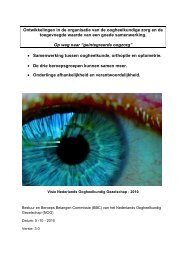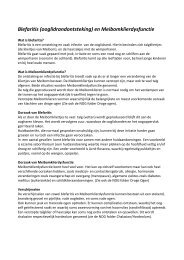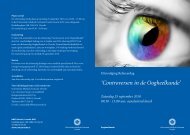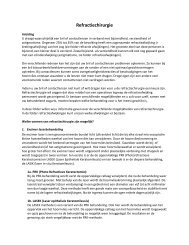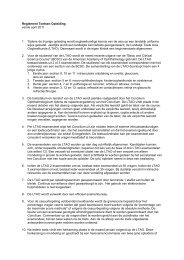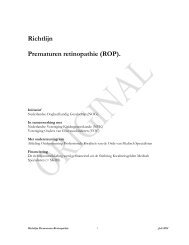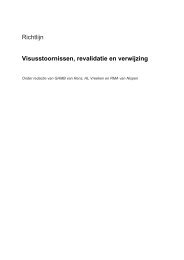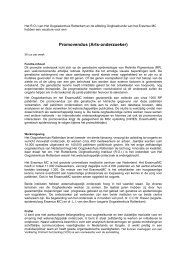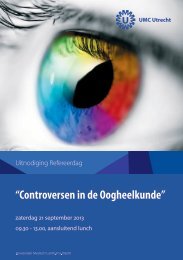terminology and guidelines for glaucoma ii - Kwaliteitskoepel
terminology and guidelines for glaucoma ii - Kwaliteitskoepel
terminology and guidelines for glaucoma ii - Kwaliteitskoepel
Create successful ePaper yourself
Turn your PDF publications into a flip-book with our unique Google optimized e-Paper software.
3.3 - ANTIGLAUCOMA DRUGS<br />
It is important when selecting medical treatment of <strong>glaucoma</strong> to underst<strong>and</strong> not only the aims of therapy, but also<br />
the mode of action, side effects <strong>and</strong> contraindications of each individual medication.<br />
It is worth remembering that the preservatives contained within topical eye drop preparations may cause inflammatory<br />
conjunctival side effects <strong>and</strong> cytotoxic effects on the ocular surface 33-35 . It is there<strong>for</strong>e important to consider the<br />
use of preservative-free preparations/delivery systems.<br />
Over the past few years there has been a gradual shift in the choice of medical therapy 36-40 . Prostagl<strong>and</strong>in derivatives/prostamides<br />
(such as bimatoprost, latanoprost <strong>and</strong> travoprost ) have in the h<strong>and</strong>s of many ophthalmolgist superceded<br />
β-blockers as their first choice. Latanoprost was approved as first-line treatment by EMEA in March 2002<br />
while applications have also been made <strong>for</strong> bimatoprost <strong>and</strong> travoprost. The CPMP extended travoprost to first-line<br />
treatment in April 2003. There is an ongoing debate in the scientific community regarding the different prostagl<strong>and</strong>ins<br />
<strong>and</strong> prostamides which has not yet been settled.<br />
If the first choice monotherapy alone is not effective on IOP or not tolerated, it is preferrable to switch to any of the<br />
other topical agents that can be initiated as monotherapy. If the first choice monotherapy is well tolerated <strong>and</strong> effective,<br />
but not sufficient to reach the target IOP, then adjunctive therapy in the <strong>for</strong>m of any other topical agent can be<br />
initiated (see FC VII, VIII <strong>and</strong> IX).<br />
It is rare nowadays <strong>for</strong> patients to be maintained on oral carbonic anhydrase inhibitors, because of their adverse<br />
systemic side-effects.<br />
INITIAL TREATMENT<br />
First choice treatment:<br />
A drug that a physician prefers to use as initial IOP lowering therapy.<br />
First line treatment:<br />
A drug that has been approved by an official controlling body (i.e. EMEA, CPMP or FDA)<br />
<strong>for</strong> initial IOP lowering therapy.<br />
Therapeutical trial<br />
Where practical, topical treatment is started in one eye at a time.<br />
The differential IOP will give a better idea of the effect, with less influence from diurnal variations.<br />
For some drugs, a cross-over effect to the fellow eye must be taken into account 41-50 .<br />
Therapeutic Index<br />
It is the ratio of desired, beneficial effects to adverse effects.<br />
Treatment is considered “effective” on IOP when the observed effect is at least equal to the<br />
pubished average effect <strong>for</strong> the same molecule on a similar population. It must be larger than<br />
tonometry errors / variations.<br />
Ch. 3 - 7 EGS



